The ARM vs x86 Wars Have Begun: In-Depth Power Analysis of Atom, Krait & Cortex A15
by Anand Lal Shimpi on January 4, 2013 7:32 AM EST- Posted in
- Tablets
- Intel
- Samsung
- Arm
- Cortex A15
- Smartphones
- Mobile
- SoCs
SunSpider 0.9.1
The results get more interesting when we look at power consumption during active workloads. We'll start off with SunSpider, a mid-length JavaScript benchmark that we frequently use in our reviews:
At the platform level, Qualcomm's APQ8060 powered Dell XPS 10 falls in between Surface RT and Acer's W510. Active power looks very similar to the Intel powered W510, but performance is appreciably slower so total energy consumed is higher.
Looking at the CPU, the situation changes a bit. Intel's peak power consumption is similar to Tegra 3, while Krait manages to come in appreciably lower. I suspect that missing the L2 cache power island here is lowering Qualcomm's power consumption by 100 - 200mW but overall CPU-only power consumption would still be lower. Once again, at idle Krait seems to have a bit of an advantage as well.
The situation changes once we look at GPU power consumption, with Intel/Imagination having the clear advantage here.

Kraken
Mozilla's Kraken benchmark is a new addition to our js performance suite, and it's a beast. The test runs for much longer than SunSpider, but largely tells a similar story:
At the platform level, Acer's W510 has slightly higher peak power consumption compared to the Dell XPS 10 but it also completes the test quicker, giving it a better overall energy usage profile.
Looking at the CPU cores themselves, Qualcomm holds onto its lead here although once again, I suspect the margin of victory is exaggerated by the fact that we're not taking into account L2 power consumption for Qualcomm. Intel does deliver better performance, which allows the CPU to race to sleep quicker than on APQ8060A.
The comparison to Tegra 3 is not surprising, this is exactly what we've seen play out in our battery life tests as well.
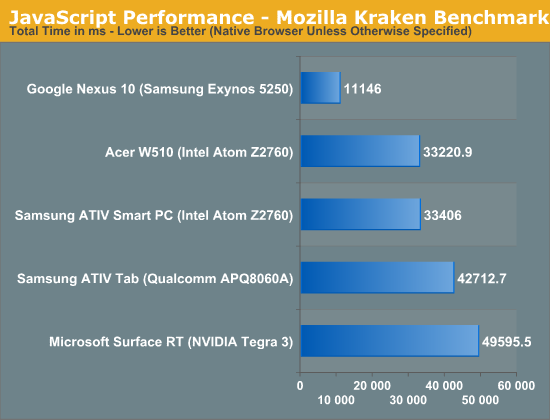
RIABench
RIABench's Focus Tests are on the other end of the spectrum, and take a matter of seconds to complete. What we get in turn is a more granular look at power consumption:
Here the W510 consumes more power at the platform level, but drops to a lower idle state than the XPS 10. Surface RT clearly uses more power than both.
Krait's CPU level (excluding L2 cache) power consumption is once again lower than Atom's, but Atom completes the task quicker. In this case total energy usage is still in Qualcomm's favor. The fact that there's a discrepancy between CPU specific power results and the total platform results are partly due to the missing L2 cache power consumption data from the CPU power chart for Qualcomm, and partly due to differences in the tablets themselves.
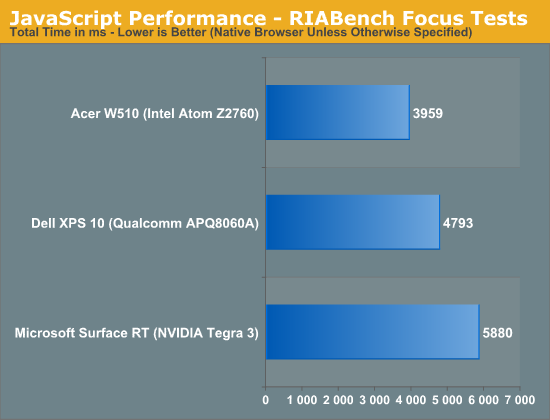


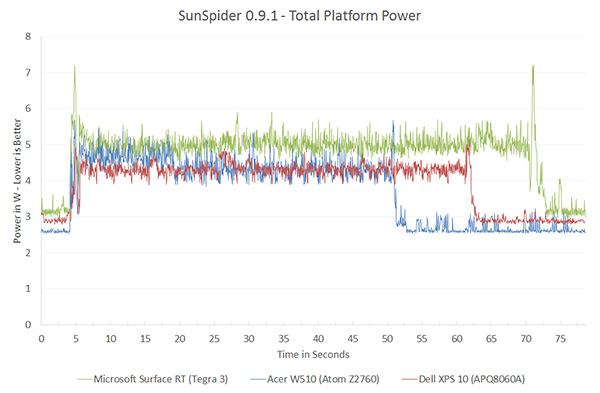


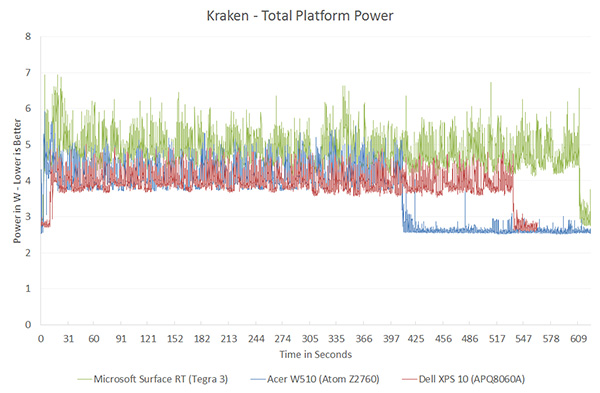
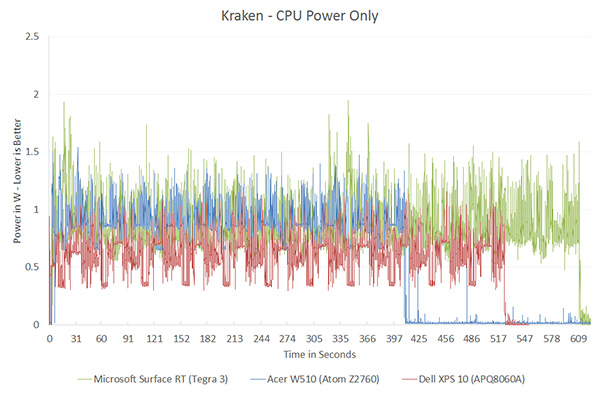
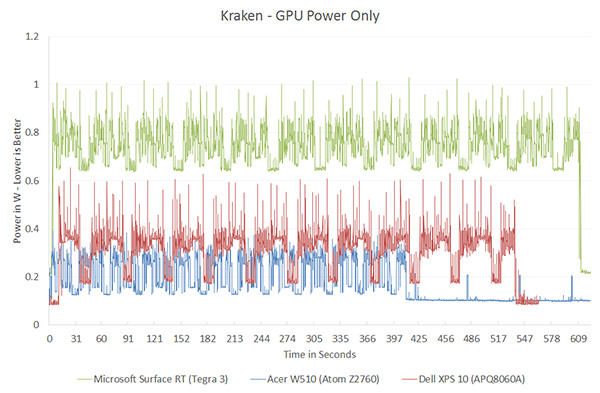
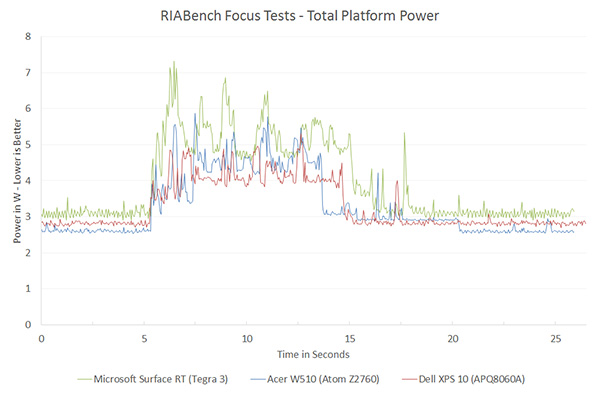
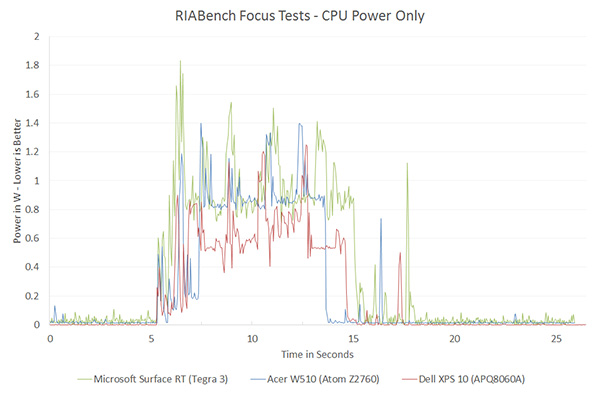
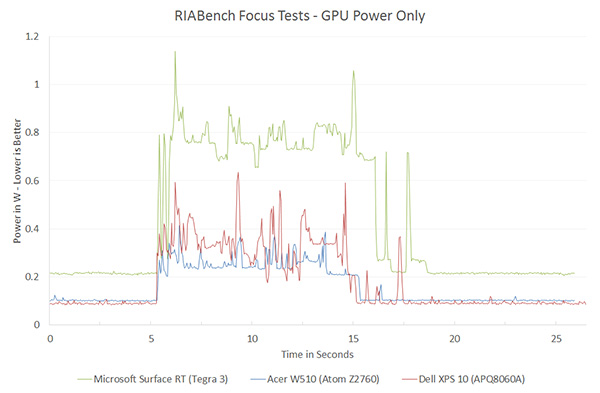








140 Comments
View All Comments
powerarmour - Friday, January 4, 2013 - link
So yes, finally confirming what anyone with half a brain knows, competitive ARM SoC's use less power.apinkel - Friday, January 4, 2013 - link
I'm assuming you are kidding.Atom is roughly equivalent to (dual core) Krait in power draw but has better performance.
The A15 is faster than either krait or the atom but it's power draw is too much to make it usable in a smartphone (which is I'm assuming why qualcomm had to redesign the A15 architecture for krait to make it fit into the smartphone power envelope).
The battle I still want to see is quad core krait and atom.
ImSpartacus - Friday, January 4, 2013 - link
Let me make sure I have this straight. Did Qualcomm redesign A15 to create Krait?djgandy - Friday, January 4, 2013 - link
No. Qualcomm create their own designs from scratch. They have an Instruction Set licence for ARM but they are arm "clones"apinkel - Friday, January 4, 2013 - link
Sorry, yeah, I could have worded that better.But in any case the comment now has me wondering if I'm off base in my understanding of how Qualcomm does what it does...
I've been under the impression that Qualcomm took the ARM design and tweaked it for their needs (instead of just licensing the instruction set and the full chip design top to bottom). Yeah/Nay?
fabarati - Friday, January 4, 2013 - link
Nay.They do what AMD does, they license the instruction set and create their own cpus that are compatible with the ARM ISA's (in Krait's case, the ARMv7). That's also what Apple did with their Swift cores.
Nvidia tweaked the Cortex A9 in the Tegra 2, but it was still a Cortex A9. Ditto for Samsung, Hummingbird and the Cortex A8.
designerfx - Friday, January 4, 2013 - link
do I need to remind you that the Tegra 3 has disabled cores on the RT? Using an actual android device with Tegra 3 would show better results.madmilk - Friday, January 4, 2013 - link
The disabled 5th core doesn't matter in loaded situations. During idle, screen power dominates, so it still doesn't really matter. About all you'll get is more standby time, and Atom seems to be doing fine there.designerfx - Friday, January 4, 2013 - link
The core allows a lot of different significant things - so in other words, it's extremely significant, including in high load situations as well.That has nothing to do with the Atom. You get more than standby time.
designerfx - Friday, January 4, 2013 - link
also, during idle the screen is off, usually after whatever amount of time the settings are set for. Which is easily indicated in the idle measurements. What the heck are you even talking about?